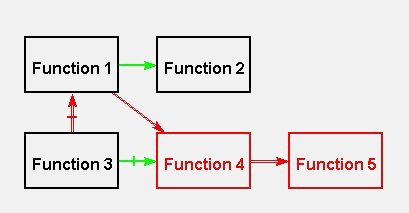
* First presented at the Altshuller Institute Conference "TRIZCON99" March 7-8, 1999
This article includes |
Attachment1 (171
KB) Attachment2 (45 KB) |
Formulation of exhaustive set of possible for analyzing system problems is very important stage of work on searching of breakthrough under TRIZ theory. After data collection and systematization of major information, translation of information to "TRIZ language" is required to ensure efficient utilization of tools of directed evolution. The translation implements by means of artificial intellect "Problem Formulator".
User makes functional description of the system in form of the graph then Problem Formulator software translating it to problem statements. This description includes exhaustive set of problems that can be formulated under this description.
There are two stages in problem formulation.
1. Preliminary formulation, that covers main technological processes, clarification and discussion of worked out formulators with Subject Matter Expert (SME.)
2. Final Formulation, that includes clarification of general and working out of detailed formulators on different processes, and also selection and analysis of obtained problem statements.
Typical Graphical Descriptions of Problem Situation includes different functions and standard links between them:

|
Provides | ([Useful] Function 2) |
|
Causes | ([Harmful] Function 4) |
|
Eliminates | ([Harmful] Function 4) |
|
Hinders | ([Useful] Function 1) |
|
Causes | ([Harmful] Function 5) |
Typical problem statements generated by Problem Formulator:
Problem Statements Analysis
After problem formulation the analysis of problem statements is performed. The following questions have to be answered for each Problem Statement developed:
It is necessary to remember:
After the analysis of each problem statement the analysis and structuring of the obtained directions and concepts is performed. Then its general list is compiled, as a rule structured by basic functions performed by the system or its main structural units.
The final conclusions for the preliminary Ideation/TRIZ analysis of the system are constructed on the basis of structured information.
Developmental Management
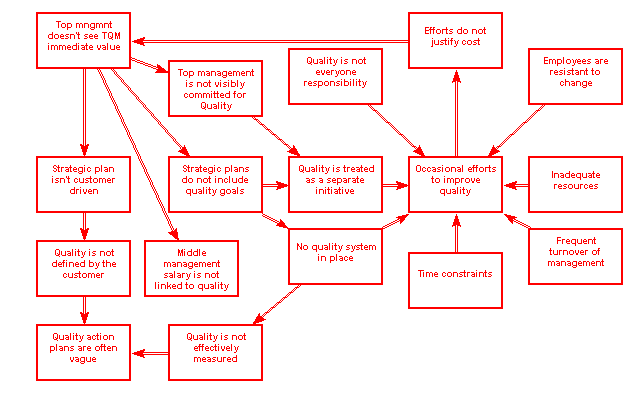
1. Find a way to eliminate, reduce or prevent [the] (Middle management salary is not linked to quality), under the condition of [the] (Top management doesn't see TQM immediate value).
2. Find a way to eliminate, reduce or prevent [the] (Inadequate resources).
3. Find a way to eliminate, reduce or prevent [the] (Quality is treated as a separate initiative), under the condition of [the] (Strategic plans do not include quality goals) and (Top management is not visibly committed for Quality).
4. Find a way to eliminate, reduce or prevent [the] (Employees are resistant to change).
5. Find a way to eliminate, reduce or prevent [the] (Time constraints).
6. Find a way to eliminate, reduce or prevent [the] (Top management is not visibly committed for Quality), under the condition of [the] (Top management doesn't see TQM immediate value).
7. Find a way to eliminate, reduce or prevent [the] (Strategic plans do not include quality goals), under the condition of [the] (Top management doesn't see TQM immediate value).
8. Find a way to eliminate, reduce or prevent [the] (Strategic plan isn't customer driven), under the condition of [the] (Top management doesn't see TQM immediate value).
9. Find a way to eliminate, reduce or prevent [the] (Quality action plans are often vague), under the condition of [the] (Quality is not effectively measured) and (Quality is not defined by the customer).
10. Find a way to eliminate, reduce or prevent [the] (Quality is not everyone responsibility).
11. Find a way to eliminate, reduce or prevent [the] (Quality is not defined by the customer), under the condition of [the] (Strategic plan isn't customer driven).
12. Find a way to eliminate, reduce or prevent [the] (Quality is not effectively measured), under the condition of [the] (No quality system in place).
13. Find a way to eliminate, reduce or prevent [the] (Frequent turnover of management).
14. Find a way to eliminate, reduce or prevent [the] (Top management doesn't see TQM immediate value), under the condition of [the] (Efforts do not justify cost).
15. Find a way to eliminate, reduce or prevent [the] (No quality system in place), under the condition of [the] (Strategic plans do not include quality goals).
16. Find a way to eliminate, reduce or prevent [the] (Occasional efforts to improve quality), under the condition of [the] (Quality is treated as a separate initiative), (No quality system in place), (Quality is not everyone responsibility), (Time constraints), (Inadequate resources), (Frequent turnover of management), and (Employees are resistant to change).
17. Find a way to eliminate, reduce or prevent [the] (Efforts do not justify cost), under the condition of [the] (Occasional efforts to improve quality).
Fire Fighting
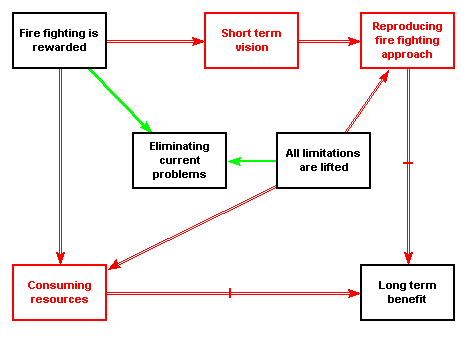
1. Find an alternative way to obtain [the] (Fire fighting is rewarded), that provides or enhances [the] (Eliminating current problems), and does not cause [the] (Short term vision) and (Consuming resources).
2. Find a way to enhance [the] (Fire fighting is rewarded).
3. Find a way to resolve the contradiction: [the] (Fire fighting is rewarded) should exist to obtain [the] (Eliminating current problems), and should not exist in order to avoid [the] (Short term vision) and (Consuming resources).
4. Find a way to do without [the] (Fire fighting is rewarded) for obtaining [the] (Eliminating current problems).
5. Find a way to eliminate, reduce or prevent [the] (Short term vision), under the condition of [the] (Fire fighting is rewarded).
6. Find an alternative way to obtain [the] (All limitations are lifted), that provides or enhances [the] (Eliminating current problems), and does not cause [the] (Reproducing fire fighting approach) and (Consuming resources).
7. Find a way to enhance [the] (All limitations are lifted).
8. Find a way to resolve the contradiction: [the] (All limitations are lifted) should exist to obtain [the] (Eliminating current problems), and should not exist in order to avoid [the] (Reproducing fire fighting approach) and (Consuming resources).
9. Find a way to do without [the] (All limitations are lifted) for obtaining [the] (Eliminating current problems).
10. Find a way to eliminate, reduce or prevent [the] (Reproducing fire fighting approach), under the condition of [the] (Short term vision) and (All limitations are lifted).
11. Find an alternative way to obtain [the] (Eliminating current problems), that does not require [the] (Fire fighting is rewarded) and (All limitations are lifted).
12. Find a way to enhance [the] (Eliminating current problems).
13. Find a way to protect [the] (Long term benefit) from the harmful influence of [the] (Reproducing fire fighting approach) and (Consuming resources).
14. Find an alternative way to obtain [the] (Long term benefit), under condition of [the] (Reproducing fire fighting approach) and (Consuming resources).
15. Find a way to enhance [the] (Long term benefit).
16. Find a way to eliminate, reduce or prevent [the] (Consuming resources), under the condition of [the] (Fire fighting is rewarded) and (All limitations are lifted).
Ideal Engineering I
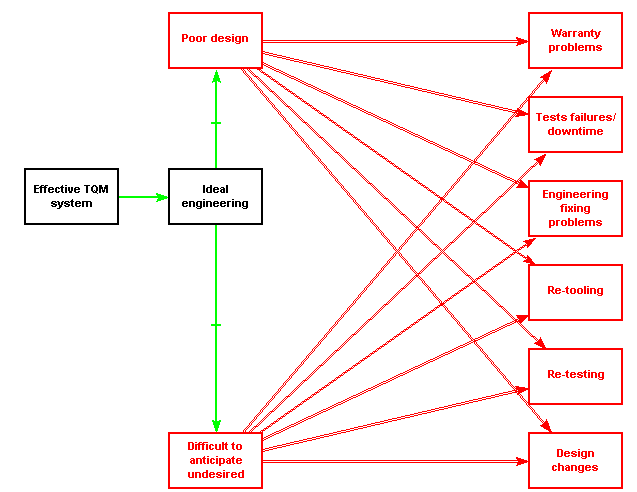
1. Find a way to eliminate, reduce or prevent [the] (Design changes), under the condition of [the] (Poor design) and (Difficult to anticipate undesired results of decisions).
2. Find a way to eliminate, reduce or prevent [the] (Warranty problems), under the condition of [the] (Poor design) and (Difficult to anticipate undesired results of decisions).
3. Find a way to eliminate, reduce or prevent [the] (Tests failures/ downtime), under the condition of [the] (Poor design) and (Difficult to anticipate undesired results of decisions).
4. Find a way to eliminate, reduce or prevent [the] (Engineering fixing problems), under the condition of [the] (Poor design) and (Difficult to anticipate undesired results of decisions).
5. Find a way to eliminate, reduce or prevent [the] (Re-tooling), under the condition of [the] (Poor design) and (Difficult to anticipate undesired results of decisions).
6. Find a way to eliminate, reduce or prevent [the] (Re-testing), under the condition of [the] (Poor design) and (Difficult to anticipate undesired results of decisions).
7. Find a way to increase the effectiveness of eliminating [the] (Difficult to anticipate undesired results of decisions) by using [the] (Ideal engineering).
8. Find an alternative way to eliminate, reduce or prevent [the] (Difficult to anticipate undesired results of decisions).
9. Find a way to increase the effectiveness of eliminating [the] (Poor design) by using [the] (Ideal engineering).
10. Find an alternative way to eliminate, reduce or prevent [the] (Poor design).
11. Find an alternative way to obtain [the] (Ideal engineering), that eliminates, reduces or prevents [the] (Difficult to anticipate undesired results of decisions) and (Poor design), and does not require [the] (Effective TQM system).
12. Find a way to enhance [the] (Ideal engineering).
13. Find a way to do without [the] (Ideal engineering) for elimination, reduction or prevention of [the] (Difficult to anticipate undesired results of decisions) and (Poor design).
14. Find an alternative way to obtain [the] (Effective TQM system), that provides or enhances [the] (Ideal engineering).
15. Find a way to enhance [the] (Effective TQM system).
16. Find a way to do without [the] (Effective TQM system) for obtaining [the] (Ideal engineering).
Ideal Engineering II

1. Find an alternative way to obtain [the] (Ideal engineering), that eliminates, reduces or prevents [the] (Design changes), (Warranty problems), (Tests failures/ downtime), (Engineering fixing problems), (Re-tooling), and (RE-testing), under condition of [the] (Producing defects).
2. Find a way to enhance [the] (Ideal engineering).
3. Find a way to protect [the] (Ideal engineering) from the harmful influence of [the] (Producing defects).
4. Find a way to do without [the] (Ideal engineering) for elimination, reduction or prevention of [the] (Design changes), (Warranty problems), (Tests failures/ downtime), (Engineering fixing problems), (Re-tooling), and (RE-testing).
5. Find a way to eliminate, reduce or prevent [the] (Engineers make mistakes), under the condition of [the] (Lack of knowledge), (Lack of effective processes), (Lack of Q&R disciplines implemented), (Insufficient and inaccurate information), (Reactive approach), (Lack of necessary skills), (Little fish effect), (Lack of commitment to long term success), (Lack of disciplines to follow the process), and (Pressure for cost, time, resources).
6. Find a way to increase the effectiveness of eliminating [the] (Design changes) by using [the] (Ideal engineering).
7. Find an alternative way to eliminate, reduce or prevent [the] (Design changes).
8. Find a way to increase the effectiveness of eliminating [the] (Warranty problems) by using [the] (Ideal engineering).
9. Find an alternative way to eliminate, reduce or prevent [the] (Warranty problems).
10. Find a way to increase the effectiveness of eliminating [the] (Tests failures/ downtime) by using [the] (Ideal engineering).
11. Find an alternative way to eliminate, reduce or prevent [the] (Tests failures/ downtime).
12. Find a way to increase the effectiveness of eliminating [the] (Engineering fixing problems) by using [the] (Ideal engineering).
13. Find an alternative way to eliminate, reduce or prevent [the] (Engineering fixing problems).
14. Find an alternative way to obtain [the] (Company profit), that does not require [the] (Pressure for cost, time, resources) and (Long term strategy), under condition of [the] (Design changes), (Warranty problems), (Tests failures/ downtime), and (Engineering fixing problems).
15. Find a way to enhance [the] (Company profit).
16. Find a way to protect [the] (Company profit) from the harmful influence of [the] (Design changes), (Warranty problems), (Tests failures/ downtime), and (Engineering fixing problems).
17. Find a way to increase the effectiveness of eliminating [the] (Re-tooling) by using [the] (Ideal engineering).
18. Find an alternative way to eliminate, reduce or prevent [the] (Re-tooling).
19. Find a way to increase the effectiveness of eliminating [the] (RE-testing) by using [the] (Ideal engineering).
20. Find an alternative way to eliminate, reduce or prevent [the] (RE-testing).
21. Find a way to increase the effectiveness of eliminating [the] (Lack of knowledge) by using [the] (Training and education).
22. Find an alternative way to eliminate, reduce or prevent [the] (Lack of knowledge).
23. Find a way to eliminate, reduce or prevent [the] (Lack of effective processes).
24. Find a way to eliminate, reduce or prevent [the] (Lack of Q&R disciplines implemented), under the condition of [the] (Engineers do not see the benefit), (Lack of knowledge), (Engineers do not understand the importance of Q&R tolls), and (Lack of software tools).
25. Find a way to eliminate, reduce or prevent [the] (Engineers do not see the benefit).
26. Find a way to eliminate, reduce or prevent [the] (Engineers do not understand the importance of Q&R tolls), under the condition of [the] (Lack of knowledge).
27. Find a way to eliminate, reduce or prevent [the] (Insufficient and inaccurate information).
28. Find a way to eliminate, reduce or prevent [the] (Reactive approach), under the condition of [the] (Lack of effective processes).
29. Find an alternative way to obtain [the] (Pressure for cost, time, resources), that provides or enhances [the] (Company profit), but does not cause [the] (Engineers make mistakes), (Lack of software tools), and (Management makes mistakes), and does not require [the] (Short term driven management). This way should not be in a conflict with [the] (Training and education).
30. Find a way to enhance [the] (Pressure for cost, time, resources).
31. Find a way to resolve the contradiction: [the] (Pressure for cost, time, resources) should exist to obtain [the] (Company profit), and should not exist in order to avoid [the] (Engineers make mistakes), (Lack of software tools), and (Management makes mistakes) and also avoid hindering [the] (Training and education).
32. Find a way to do without [the] (Pressure for cost, time, resources) for obtaining [the] (Company profit).
33. Find a way to eliminate, reduce or prevent [the] (Management makes mistakes), under the condition of [the] (Short term driven management) and (Pressure for cost, time, resources).
34. Find a way to eliminate, reduce or prevent [the] (Producing defects), under the condition of [the] (Management makes mistakes) and (Engineers make mistakes).
35. Find a way to increase the effectiveness of eliminating [the] (Lack of necessary skills) by using [the] (Training and education).
36. Find an alternative way to eliminate, reduce or prevent [the] (Lack of necessary skills).
37. Find an alternative way to obtain [the] (Short term driven management), that provides or enhances [the] (Promotion) and (Pressure for cost, time, resources), but does not cause [the] (Management makes mistakes). This way should not be in a conflict with [the] (Long term strategy).
38. Find a way to enhance [the] (Short term driven management).
39. Find a way to resolve the contradiction: [the] (Short term driven management) should exist to obtain [the] (Promotion) and (Pressure for cost, time, resources), and should not exist in order to avoid [the] (Management makes mistakes) and also avoid hindering [the] (Long term strategy).
40. Find a way to do without [the] (Short term driven management) for obtaining [the] (Promotion) and (Pressure for cost, time, resources).
41. Find an alternative way to obtain [the] (Promotion), that does not require [the] (Short term driven management) and (Constant rotation of people).
42. Find a way to enhance [the] (Promotion).
43. Find an alternative way to obtain [the] (Long term strategy), that provides or enhances [the] (Company profit), under condition of [the] (Short term driven management).
44. Find a way to enhance [the] (Long term strategy).
45. Find a way to protect [the] (Long term strategy) from the harmful influence of [the] (Short term driven management).
46. Find a way to do without [the] (Long term strategy) for obtaining [the] (Company profit).
47. Find an alternative way to obtain [the] (Constant rotation of people), that provides or enhances [the] (Promotion), and does not cause [the] (Lack of necessary skills) and (Lack of knowledge).
48. Find a way to enhance [the] (Constant rotation of people).
49. Find a way to resolve the contradiction: [the] (Constant rotation of people) should exist to obtain [the] (Promotion), and should not exist in order to avoid [the] (Lack of necessary skills) and (Lack of knowledge).
50. Find a way to do without [the] (Constant rotation of people) for obtaining [the] (Promotion).
51. Find a way to eliminate, reduce or prevent [the] (Difficult to anticipate undesired results of decisions).
52. Find an alternative way to obtain [the] (Training and education), that eliminates, reduces or prevents [the] (Lack of knowledge) and (Lack of necessary skills), under condition of [the] (Lack of software tools) and (Pressure for cost, time, resources).
53. Find a way to enhance [the] (Training and education).
54. Find a way to protect [the] (Training and education) from the harmful influence of [the] (Lack of software tools) and (Pressure for cost, time, resources).
55. Find a way to do without [the] (Training and education) for elimination, reduction or prevention of [the] (Lack of knowledge) and (Lack of necessary skills).
56. Find a way to eliminate, reduce or prevent [the] (Lack of software tools), under the condition of [the] (Pressure for cost, time, resources).
57. Find a way to eliminate, reduce or prevent [the] (Little fish effect).
58. Find a way to eliminate, reduce or prevent [the] (Lack of commitment to long term success), under the condition of [the] (Little fish effect).
59. Find a way to eliminate, reduce or prevent [the] (Lack of disciplines to follow the process).
Main inhibitors
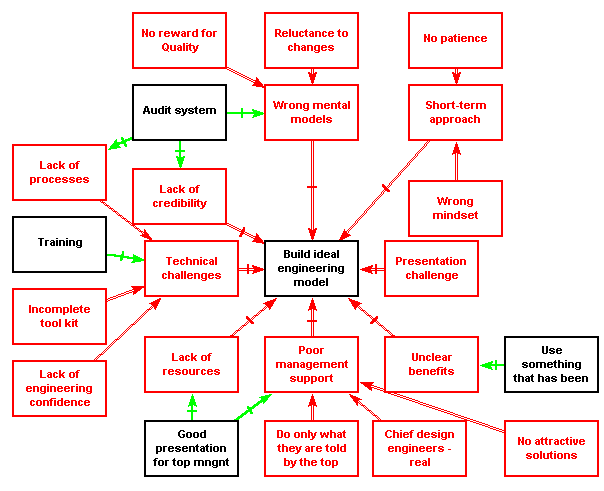
1. Find a way to protect [the] (Build ideal engineering model) from the harmful influence of [the] (Lack of credibility), (Presentation challenge), (Poor management support), (Technical challenges), (Lack of resources), (Short-term approach), (Unclear benefits), and (Wrong mental models).
2. Find an alternative way to obtain [the] (Build ideal engineering model), under condition of [the] (Lack of credibility), (Presentation challenge), (Poor management support), (Technical challenges), (Lack of resources), (Short-term approach), (Unclear benefits), and (Wrong mental models).
3. Find a way to enhance [the] (Build ideal engineering model).
4. Find a way to eliminate, reduce or prevent [the] (Reluctance to changes).
5. Find a way to increase the effectiveness of eliminating [the] (Lack of credibility) by using [the] (Audit system).
6. Find an alternative way to eliminate, reduce or prevent [the] (Lack of credibility).
7. Find a way to eliminate, reduce or prevent [the] (Presentation challenge).
8. Find a way to increase the effectiveness of eliminating [the] (Poor management support) by using [the] (Good presentation for top mngnt).
9. Find an alternative way to eliminate, reduce or prevent [the] (Poor management support).
10. Find a way to increase the effectiveness of eliminating [the] (Technical challenges) by using [the] (Training).
11. Find an alternative way to eliminate, reduce or prevent [the] (Technical challenges).
12. Find a way to eliminate, reduce or prevent [the] (Short-term approach), under the condition of [the] (Wrong mindset) and (No patience).
13. Find a way to increase the effectiveness of eliminating [the] (Lack of resources) by using [the] (Good presentation for top mngnt).
14. Find an alternative way to eliminate, reduce or prevent [the] (Lack of resources).
15. Find a way to eliminate, reduce or prevent [the] (Wrong mindset).
16. Find a way to increase the effectiveness of eliminating [the] (Unclear benefits) by using [the] (Use something that has been tested before in your or another industry.).
17. Find an alternative way to eliminate, reduce or prevent [the] (Unclear benefits).
18. Find a way to eliminate, reduce or prevent [the] (Incomplete tool kit).
19. Find a way to increase the effectiveness of eliminating [the] (Lack of processes) by using [the] (Audit system).
20. Find an alternative way to eliminate, reduce or prevent [the] (Lack of processes).
21. Find a way to eliminate, reduce or prevent [the] (Lack of engineering confidence).
22. Find a way to eliminate, reduce or prevent [the] (No attractive solutions).
23. Find a way to eliminate, reduce or prevent [the] (Do only what they are told by the top mngmnt).
24. Find a way to eliminate, reduce or prevent [the] (Chief design engineers - real customers).
25. Find a way to increase the effectiveness of eliminating [the] (Wrong mental models) by using [the] (Audit system).
26. Find an alternative way to eliminate, reduce or prevent [the] (Wrong mental models).
27. Find an alternative way to obtain [the] (Audit system), that eliminates, reduces or prevents [the] (Wrong mental models), (Lack of credibility), and (Lack of processes).
28. Find a way to enhance [the] (Audit system).
29. Find a way to do without [the] (Audit system) for elimination, reduction or prevention of [the] (Wrong mental models), (Lack of credibility), and (Lack of processes).
30. Find a way to eliminate, reduce or prevent [the] (No reward for Quality).
31. Find an alternative way to obtain [the] (Training), that eliminates, reduces or prevents [the] (Technical challenges).
32. Find a way to enhance [the] (Training).
33. Find a way to do without [the] (Training) for elimination, reduction or prevention of [the] (Technical challenges).
34. Find an alternative way to obtain [the] (Good presentation for top mngnt), that eliminates, reduces or prevents [the] (Poor management support) and (Lack of resources).
35. Find a way to enhance [the] (Good presentation for top mngnt).
36. Find a way to do without [the] (Good presentation for top mngnt) for elimination, reduction or prevention of [the] (Poor management support) and (Lack of resources).
37. Find a way to eliminate, reduce or prevent [the] (No patience).
38. Find an alternative way to obtain [the] (Use something that has been tested before in your or another industry.), that eliminates, reduces or prevents [the] (Unclear benefits).
39. Find a way to enhance [the] (Use something that has been tested before in your or another industry.).
40. Find a way to do without [the] (Use something that has been tested before in your or another industry.) for elimination, reduction or prevention of [the] (Unclear benefits).
Operational management

1. Find an alternative way to obtain [the] (Company profit), that does not require [the] (Pressure for cost, time, resources) and (Long term strategy).
2. Find a way to enhance [the] (Company profit).
3. Find an alternative way to obtain [the] (Pressure for cost, time, resources), that provides or enhances [the] (Company profit), but does not cause [the] (Management makes mistakes), and does not require [the] (Short term driven management). This way should not be in a conflict with [the] (Training and education).
4. Find a way to enhance [the] (Pressure for cost, time, resources).
5. Find a way to resolve the contradiction: [the] (Pressure for cost, time, resources) should exist to obtain [the] (Company profit), and should not exist in order to avoid [the] (Management makes mistakes) and also avoid hindering [the] (Training and education).
6. Find a way to do without [the] (Pressure for cost, time, resources) for obtaining [the] (Company profit).
7. Find a way to eliminate, reduce or prevent [the] (Management makes mistakes), under the condition of [the] (Short term driven management), (Misunderstanding value of quality management), (Pressure for cost, time, resources), and (Selection of customary way).
8. Find a way to eliminate, reduce or prevent [the] (Producing defects), under the condition of [the] (Management makes mistakes).
9. Find a way to eliminate, reduce or prevent [the] (Short term driven management), under the condition of [the] (Constant rotation of people). Then consider how to obtain [the] (Promotion) and (Pressure for cost, time, resources).
10. Find a way to resolve the contradiction: [the] (Short term driven management) should not exist in order to avoid harm, and should exist to obtain [the] (Promotion) and (Pressure for cost, time, resources).
11. Find an alternative way to obtain [the] (Promotion), that does not require [the] (Constant rotation of people) and (Short term driven management).
12. Find a way to enhance [the] (Promotion).
13. Find an alternative way to obtain [the] (Long term strategy), that provides or enhances [the] (Company profit), under condition of [the] (Short term driven management).
14. Find a way to enhance [the] (Long term strategy).
15. Find a way to protect [the] (Long term strategy) from the harmful influence of [the] (Short term driven management).
16. Find a way to do without [the] (Long term strategy) for obtaining [the] (Company profit).
17. Find an alternative way to obtain [the] (Constant rotation of people), that provides or enhances [the] (Promotion), and does not cause [the] (Short term driven management).
18. Find a way to enhance [the] (Constant rotation of people).
19. Find a way to resolve the contradiction: [the] (Constant rotation of people) should exist to obtain [the] (Promotion), and should not exist in order to avoid [the] (Short term driven management).
20. Find a way to do without [the] (Constant rotation of people) for obtaining [the] (Promotion).
21. Find a way to protect [the] (Training and education) from the harmful influence of [the] (Pressure for cost, time, resources).
22. Find an alternative way to obtain [the] (Training and education), under condition of [the] (Pressure for cost, time, resources).
23. Find a way to enhance [the] (Training and education).
24. Find a way to eliminate, reduce or prevent [the] (Misunderstanding value of quality management).
25. Find an alternative way to obtain [the] (Selection of customary way), that provides or enhances [the] (Energy and time saving), and does not cause [the] (Management makes mistakes).
26. Find a way to enhance [the] (Selection of customary way).
27. Find a way to resolve the contradiction: [the] (Selection of customary way) should exist to obtain [the] (Energy and time saving), and should not exist in order to avoid [the] (Management makes mistakes).
28. Find a way to do without [the] (Selection of customary way) for obtaining [the] (Energy and time saving).
29. Find an alternative way to obtain [the] (Energy and time saving), that does not require [the] (Selection of customary way).
30. Find a way to enhance [the] (Energy and time saving).
Poor Quality Reinforcement
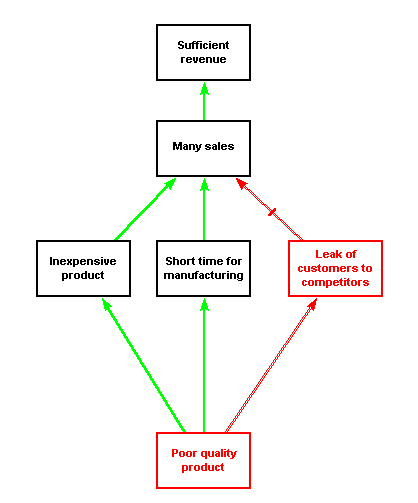
1. Find a way to resolve the contradiction: [the] (Poor quality product) should not exist in order to avoid harm, and should exist to obtain [the] (Inexpensive product) and (Short time for manufacturing).
2. Find a way to eliminate, reduce or prevent [the] (Poor quality product). Then consider how to obtain [the] (Inexpensive product) and (Short time for manufacturing).
3. Find an alternative way to obtain [the] (Many sales), that provides or enhances [the] (Sufficient revenue), and does not require [the] (Inexpensive product) and (Short time for manufacturing). This way should not be influenced by [the] (Leak of customers to competitors).
4. Find a way to enhance [the] (Many sales).
5. Find a way to protect [the] (Many sales) from the harmful influence of [the] (Leak of customers to competitors).
6. Find a way to do without [the] (Many sales) for obtaining [the] (Sufficient revenue).
7. Find an alternative way to obtain [the] (Sufficient revenue), that does not require [the] (Many sales).
8. Find a way to enhance [the] (Sufficient revenue).
9. Find a way to eliminate, reduce or prevent [the] (Leak of customers to competitors), under the condition of [the] (Poor quality product).
10. Find an alternative way to obtain [the] (Inexpensive product), that provides or enhances [the] (Many sales), and does not require [the] (Poor quality product).
11. Find a way to enhance [the] (Inexpensive product).
12. Find a way to do without [the] (Inexpensive product) for obtaining [the] (Many sales).
13. Find an alternative way to obtain [the] (Short time for manufacturing), that provides or enhances [the] (Many sales), and does not require [the] (Poor quality product).
14. Find a way to enhance [the] (Short time for manufacturing).
15. Find a way to do without [the] (Short time for manufacturing) for obtaining [the] (Many sales).
Quality inhibitors
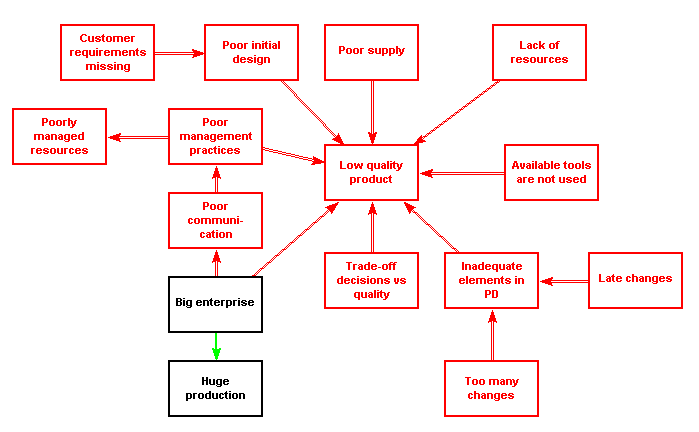
1. Find a way to eliminate, reduce or prevent [the] (Low quality product), under the condition of [the] (Poor management practices), (Lack of resources), (Inadequate elements in PD), (Available tools are not used), (Poor initial design), (Trade-off decisions vs quality), (Poor supply), and (Big enterprise).
2. Find a way to eliminate, reduce or prevent [the] (Poor management practices), under the condition of [the] (Poor communication).
3. Find a way to eliminate, reduce or prevent [the] (Poorly managed resources), under the condition of [the] (Poor management practices).
4. Find a way to eliminate, reduce or prevent [the] (Lack of resources).
5. Find a way to eliminate, reduce or prevent [the] (Inadequate elements in PD), under the condition of [the] (Too many changes) and (Late changes).
6. Find a way to eliminate, reduce or prevent [the] (Available tools are not used).
7. Find a way to eliminate, reduce or prevent [the] (Poor initial design), under the condition of [the] (Customer requirements missing).
8. Find a way to eliminate, reduce or prevent [the] (Trade-off decisions vs quality).
9. Find a way to eliminate, reduce or prevent [the] (Poor communication), under the condition of [the] (Big enterprise).
10. Find an alternative way to obtain [the] (Big enterprise), that provides or enhances [the] (Huge production), and does not cause [the] (Low quality product) and (Poor communication).
11. Find a way to enhance [the] (Big enterprise).
12. Find a way to resolve the contradiction: [the] (Big enterprise) should exist to obtain [the] (Huge production), and should not exist in order to avoid [the] (Low quality product) and (Poor communication).
13. Find a way to do without [the] (Big enterprise) for obtaining [the] (Huge production).
14. Find an alternative way to obtain [the] (Huge production), that does not require [the] (Big enterprise).
15. Find a way to enhance [the] (Huge production).
16. Find a way to eliminate, reduce or prevent [the] (Too many changes).
17. Find a way to eliminate, reduce or prevent [the] (Late changes).
18. Find a way to eliminate, reduce or prevent [the] (Customer requirements missing).
19. Find a way to eliminate, reduce or prevent [the] (Poor supply).
Quality System
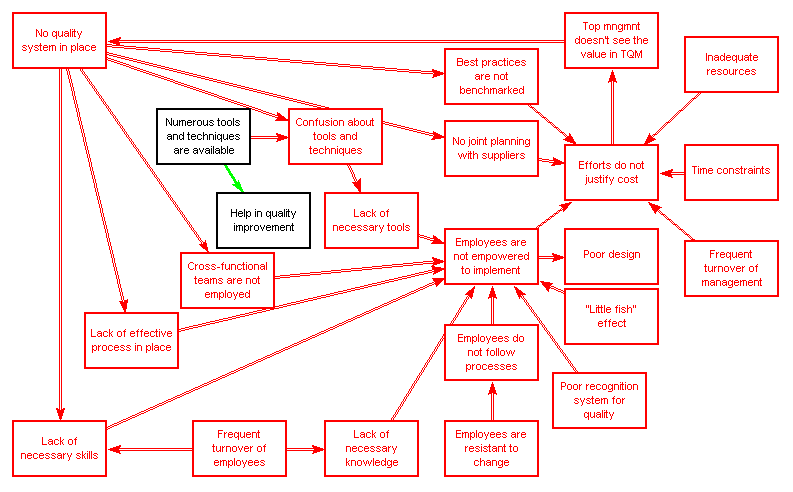
1. Find a way to eliminate, reduce or prevent [the] (Inadequate resources).
2. Find a way to eliminate, reduce or prevent [the] (Best practices are not benchmarked), under the condition of [the] (No quality system in place).
3. Find a way to eliminate, reduce or prevent [the] (Poor recognition system for quality).
4. Find a way to eliminate, reduce or prevent [the] (Employees are not empowered to implement quality improvement process), under the condition of [the] (Poor recognition system for quality), (Employees do not follow processes), (Lack of necessary tools), (Lack of necessary knowledge), (Lack of necessary skills), (Lack of effective process in place), ("Little fish" effect), and (Cross-functional teams are not employed).
5. Find a way to eliminate, reduce or prevent [the] (Employees are resistant to change).
6. Find a way to eliminate, reduce or prevent [the] (Time constraints).
7. Find a way to eliminate, reduce or prevent [the] (No joint planning with suppliers), under the condition of [the] (No quality system in place).
8. Find a way to eliminate, reduce or prevent [the] (Cross-functional teams are not employed), under the condition of [the] (No quality system in place).
9. Find a way to eliminate, reduce or prevent [the] (Frequent turnover of employees).
10. Find a way to eliminate, reduce or prevent [the] (Frequent turnover of management).
11. Find a way to eliminate, reduce or prevent [the] (Top mngmnt doesn't see the value in TQM), under the condition of [the] (Efforts do not justify cost).
12. Find a way to eliminate, reduce or prevent [the] (No quality system in place), under the condition of [the] (Top mngmnt doesn't see the value in TQM).
13. Find a way to eliminate, reduce or prevent [the] (Efforts do not justify cost), under the condition of [the] (Best practices are not benchmarked), (No joint planning with suppliers), (Employees are not empowered to implement quality improvement process), (Frequent turnover of management), (Inadequate resources), and (Time constraints).
14. Find a way to eliminate, reduce or prevent [the] (Lack of necessary skills), under the condition of [the] (No quality system in place) and (Frequent turnover of employees).
15. Find a way to eliminate, reduce or prevent [the] (Lack of necessary tools), under the condition of [the] (Confusion about tools and techniques).
16. Find a way to eliminate, reduce or prevent [the] (Lack of effective process in place), under the condition of [the] (No quality system in place).
17. Find a way to eliminate, reduce or prevent [the] (Employees do not follow processes), under the condition of [the] (Employees are resistant to change).
18. Find a way to eliminate, reduce or prevent [the] (Lack of necessary knowledge), under the condition of [the] (Frequent turnover of employees).
19. Find a way to eliminate, reduce or prevent [the] (Confusion about tools and techniques), under the condition of [the] (No quality system in place) and (Numerous tools and techniques are available).
20. Find an alternative way to obtain [the] (Numerous tools and techniques are available), that provides or enhances [the] (Help in quality improvement), and does not cause [the] (Confusion about tools and techniques).
21. Find a way to enhance [the] (Numerous tools and techniques are available).
22. Find a way to resolve the contradiction: [the] (Numerous tools and techniques are available) should exist to obtain [the] (Help in quality improvement), and should not exist in order to avoid [the] (Confusion about tools and techniques).
23. Find a way to do without [the] (Numerous tools and techniques are available) for obtaining [the] (Help in quality improvement).
24. Find a way to eliminate, reduce or prevent [the] ("Little fish" effect).
25. Find an alternative way to obtain [the] (Help in quality improvement), that does not require [the] (Numerous tools and techniques are available).
26. Find a way to enhance [the] (Help in quality improvement).
27. Find a way to eliminate, reduce or prevent [the] (Poor design), under the condition of [the] (Employees are not empowered to implement quality improvement process).
Short Term Drivers
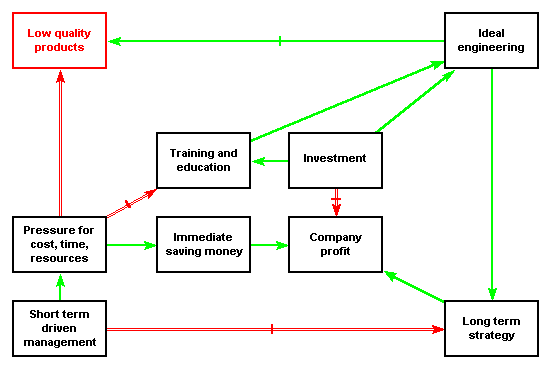
1. Find an alternative way to obtain [the] (Ideal engineering), that provides or enhances [the] (Long term strategy), eliminates, reduces or prevents [the] (Low quality products), and does not require [the] (Training and education) and (Investment).
2. Find a way to enhance [the] (Ideal engineering).
3. Find a way to do without [the] (Ideal engineering) for obtaining [the] (Long term strategy) and elimination, reduction or prevention of [the] (Low quality products).
4. Find an alternative way to obtain [the] (Company profit), that does not require [the] (Long term strategy) and (Immediate saving money), under condition of [the] (Investment).
5. Find a way to enhance [the] (Company profit).
6. Find a way to protect [the] (Company profit) from the harmful influence of [the] (Investment).
7. Find an alternative way to obtain [the] (Pressure for cost, time, resources), that provides or enhances [the] (Immediate saving money), but does not cause [the] (Low quality products), and does not require [the] (Short term driven management). This way should not be in a conflict with [the] (Training and education).
8. Find a way to enhance [the] (Pressure for cost, time, resources).
9. Find a way to resolve the contradiction: [the] (Pressure for cost, time, resources) should exist to obtain [the] (Immediate saving money), and should not exist in order to avoid [the] (Low quality products) and also avoid hindering [the] (Training and education).
10. Find a way to do without [the] (Pressure for cost, time, resources) for obtaining [the] (Immediate saving money).
11. Find an alternative way to obtain [the] (Short term driven management), that provides or enhances [the] (Pressure for cost, time, resources). This way should not be in a conflict with [the] (Long term strategy).
12. Find a way to enhance [the] (Short term driven management).
13. Find a way to resolve the contradiction: [the] (Short term driven management) should exist to obtain [the] (Pressure for cost, time, resources), and should not exist in order to avoid hindering [the] (Long term strategy).
14. Find a way to do without [the] (Short term driven management) for obtaining [the] (Pressure for cost, time, resources).
15. Find an alternative way to obtain [the] (Long term strategy), that provides or enhances [the] (Company profit), and does not require [the] (Ideal engineering). This way should not be influenced by [the] (Short term driven management).
16. Find a way to enhance [the] (Long term strategy).
17. Find a way to protect [the] (Long term strategy) from the harmful influence of [the] (Short term driven management).
18. Find a way to do without [the] (Long term strategy) for obtaining [the] (Company profit).
19. Find an alternative way to obtain [the] (Training and education), that provides or enhances [the] (Ideal engineering), and does not require [the] (Investment). This way should not be influenced by [the] (Pressure for cost, time, resources).
20. Find a way to enhance [the] (Training and education).
21. Find a way to protect [the] (Training and education) from the harmful influence of [the] (Pressure for cost, time, resources).
22. Find a way to do without [the] (Training and education) for obtaining [the] (Ideal engineering).
23. Find a way to increase the effectiveness of eliminating [the] (Low quality products) by using [the] (Ideal engineering).
24. Find an alternative way to eliminate, reduce or prevent [the] (Low quality products).
25. Find an alternative way to obtain [the] (Immediate saving money), that provides or enhances [the] (Company profit), and does not require [the] (Pressure for cost, time, resources).
26. Find a way to enhance [the] (Immediate saving money).
27. Find a way to do without [the] (Immediate saving money) for obtaining [the] (Company profit).
28. Find an alternative way to obtain [the] (Investment), that provides or enhances [the] (Ideal engineering) and (Training and education). This way should not be in a conflict with [the] (Company profit).
29. Find a way to enhance [the] (Investment).
30. Find a way to resolve the contradiction: [the] (Investment) should exist to obtain [the] (Ideal engineering) and (Training and education), and should not exist in order to avoid hindering [the] (Company profit).
31. Find a way to do without [the] (Investment) for obtaining [the] (Ideal engineering) and (Training and education).
Strategic Management
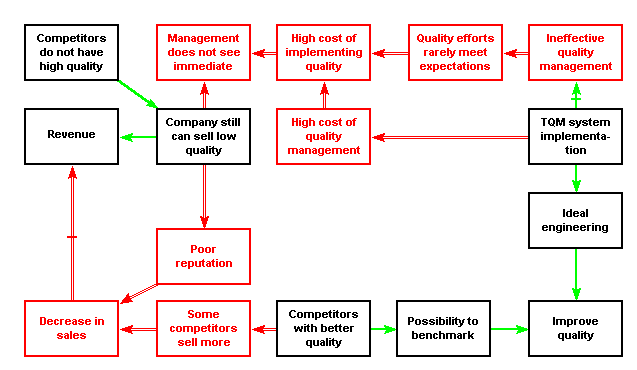
1. Find a way to eliminate, reduce or prevent [the] (Quality efforts rarely meet expectations), under the condition of [the] (Ineffective quality management).
2. Find a way to eliminate, reduce or prevent [the] (High cost of implementing quality management outweigh the benefits), under the condition of [the] (High cost of quality management) and (Quality efforts rarely meet expectations).
3. Find a way to eliminate, reduce or prevent [the] (High cost of quality management), under the condition of [the] (TQM system implementation).
4. Find a way to eliminate, reduce or prevent [the] (Management does not see immediate value in TQM), under the condition of [the] (High cost of implementing quality management outweigh the benefits) and (Company still can sell low quality products).
5. Find an alternative way to obtain [the] (Company still can sell low quality products), that provides or enhances [the] (Revenue), but does not cause [the] (Management does not see immediate value in TQM) and (Poor reputation), and does not require [the] (Competitors do not have high quality).
6. Find a way to enhance [the] (Company still can sell low quality products).
7. Find a way to resolve the contradiction: [the] (Company still can sell low quality products) should exist to obtain [the] (Revenue), and should not exist in order to avoid [the] (Management does not see immediate value in TQM) and (Poor reputation).
8. Find a way to do without [the] (Company still can sell low quality products) for obtaining [the] (Revenue).
9. Find an alternative way to obtain [the] (Revenue), that does not require [the] (Company still can sell low quality products), under condition of [the] (Decrease in sales).
10. Find a way to enhance [the] (Revenue).
11. Find a way to protect [the] (Revenue) from the harmful influence of [the] (Decrease in sales).
12. Find a way to eliminate, reduce or prevent [the] (Poor reputation), under the condition of [the] (Company still can sell low quality products).
13. Find an alternative way to obtain [the] (Competitors do not have high quality), that provides or enhances [the] (Company still can sell low quality products).
14. Find a way to enhance [the] (Competitors do not have high quality).
15. Find a way to do without [the] (Competitors do not have high quality) for obtaining [the] (Company still can sell low quality products).
16. Find a way to eliminate, reduce or prevent [the] (Decrease in sales), under the condition of [the] (Poor reputation) and (Some competitors sell more products).
17. Find a way to eliminate, reduce or prevent [the] (Some competitors sell more products), under the condition of [the] (Competitors with better quality).
18. Find an alternative way to obtain [the] (Competitors with better quality), that provides or enhances [the] (Possibility to benchmark), and does not cause [the] (Some competitors sell more products).
19. Find a way to enhance [the] (Competitors with better quality).
20. Find a way to resolve the contradiction: [the] (Competitors with better quality) should exist to obtain [the] (Possibility to benchmark), and should not exist in order to avoid [the] (Some competitors sell more products).
21. Find a way to do without [the] (Competitors with better quality) for obtaining [the] (Possibility to benchmark).
22. Find an alternative way to obtain [the] (Possibility to benchmark), that provides or enhances [the] (Improve quality), and does not require [the] (Competitors with better quality).
23. Find a way to enhance [the] (Possibility to benchmark).
24. Find a way to do without [the] (Possibility to benchmark) for obtaining [the] (Improve quality).
25. Find an alternative way to obtain [the] (Improve quality), that does not require [the] (Possibility to benchmark) and (Ideal engineering).
26. Find a way to enhance [the] (Improve quality).
27. Find an alternative way to obtain [the] (TQM system implementation), that provides or enhances [the] (Ideal engineering), eliminates, reduces or prevents [the] (Ineffective quality management), but does not cause [the] (High cost of quality management).
28. Find a way to enhance [the] (TQM system implementation).
29. Find a way to resolve the contradiction: [the] (TQM system implementation) should exist to obtain [the] (Ideal engineering) and also avoid hindering [the] (Ineffective quality management), and should not exist in order to avoid [the] (High cost of quality management).
30. Find a way to do without [the] (TQM system implementation) for obtaining [the] (Ideal engineering) and elimination, reduction or prevention of [the] (Ineffective quality management).
31. Find a way to increase the effectiveness of eliminating [the] (Ineffective quality management) by using [the] (TQM system implementation).
32. Find an alternative way to eliminate, reduce or prevent [the] (Ineffective quality management).
33. Find an alternative way to obtain [the] (Ideal engineering), that provides or enhances [the] (Improve quality), and does not require [the] (TQM system implementation).
34. Find a way to enhance [the] (Ideal engineering).
35. Find a way to do without [the] (Ideal engineering) for obtaining [the] (Improve quality).
This article includes |
Attachment1 (171
KB) Attachment2 (45 KB) |